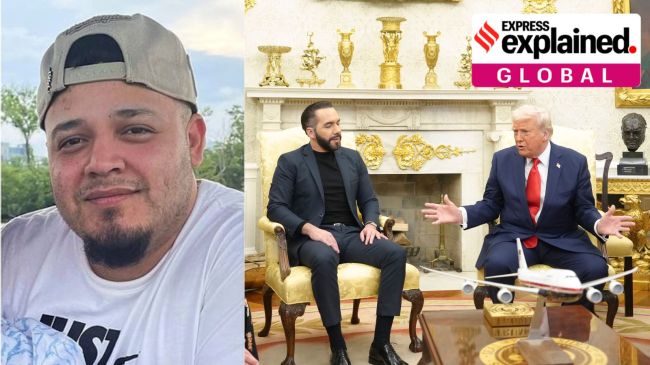Opinion How wrongful deportation of Maryland man to El Salvador pits Team Trump against the law
Abrego Garcia lived in Maryland with his wife and children, and worked as a sheet metal worker, according to his lawyers. He was wrongly deported to El Salvador last month.
 Left: Abrego Garcia. Right: President Donald Trump with President Nayib Bukele of El Salvador in the White House in Washington, on Monday, April 14, 2025. (AP, NYT Photos)
Left: Abrego Garcia. Right: President Donald Trump with President Nayib Bukele of El Salvador in the White House in Washington, on Monday, April 14, 2025. (AP, NYT Photos) A US federal judge on Tuesday (April 14) ordered a two-week inquiry into the inaction by the Trump administration to seek the return of a man wrongly deported to El Salvador from Maryland.
 District Judge Paula Xinis said that Trump officials had disobeyed a “clear” Supreme Court order to enable the return of 29-year-old Kilmar Abrego Garcia. “To date, what the record shows is that nothing has been done. Nothing,” she said.
District Judge Paula Xinis said that Trump officials had disobeyed a “clear” Supreme Court order to enable the return of 29-year-old Kilmar Abrego Garcia. “To date, what the record shows is that nothing has been done. Nothing,” she said.The hearing comes a day after El Salvador President Nayib Bukele said he would not return Garcia, comparing it to smuggling a “terrorist into the United States”. Meanwhile, Trump and senior White House officials have claimed they lack the authority to return Garcia to the US.
First, about Abrego Garcia’s deportation
Abrego Garcia had illegally crossed into the US as a 16-year-old around 2011 to escape gang violence in El Salvador, according to his lawyers. He was picked up by Immigration and Customs Enforcement (ICE) in 2019 following a submission by a confidential informant alleging he was affiliated with the New York chapter of the feared Salvadoran gang MS-13. He appealed for asylum and lost, but in October 2019, an immigration judge granted him protection from deportation to El Salvador based on a “well-founded fear” of gang persecution. ICE did not challenge this ruling.
Before his deportation, Abrego Garcia lived with his wife and children in Maryland, all US citizens. His lawyers claim he worked as a sheet metal worker and was a union member with no criminal record.
While the Trump administration has (later) described the deportation as an “administrative error”, they have relied on the 2019 hearing to repeatedly assert that he was a member of MS-13, known for smuggling drugs and people, extortion and murder.
Abrego Garcia is currently locked in the Terrorism Confinement Centre, also called the CECOT megaprison in El Salvador, known for its human rights abuses and lack of legal recourse. Since March, the US has deported large groups of undocumented immigrants to the country, often without establishing their criminal connection. While some of the men have been deported under the Alien Enemies Act (which allows deportations of individuals who pose a threat to national security during wartime), many – including Abrego Garcia – were deported under regular immigration law.
An Associated Press report revealed that this arrangement to house deportees from the US in CECOT has cost it $6 million.
US Supreme Court vs Trump
On April 4, Judge Xinis ordered the US government to “facilitate and effectuate” Abrego Garcia’s return by 11:59 pm on April 7. She wrote, “Defendants seized Abrego Garcia without any lawful authority; held him in three separate domestic detention centers without legal basis; failed to present him to any immigration judge or officer; and forcibly transported him to El Salvador in direct contravention of the INA (Immigration and Nationality Act).”
The Trump administration moved the Supreme Court to challenge this ruling. On April 10, the SC unanimously upheld District Judge Xinis’s order for the US administration to “facilitate” Abrego Garcia’s release and return from El Salvador. In the 9-0 verdict, the SC declined to block her judgment, but sought clarity on the term “effectuate”, saying she may have exceeded her judicial authority in seeking daily updates on the status.
Trump and co. have presented a defiant front so far: they have claimed that the federal courts do not enjoy jurisdiction in the present case since it concerns the diplomatic powers of the executive branch. However, this contention was dismissed by the SC, which wrote, “The United States Government has no legal authority to snatch a person who is lawfully present in the United States off the street and remove him from the country without due process. The Government’s contention otherwise, and its argument that the federal courts are powerless to intervene are unconscionable.”
As Presidents Trump and Bukele met at the White House on Monday, both denied the possibility of bringing back Abrego Garcia.
Ahead of the SC decision last week, Trump promised he would abide by it, saying, “If the Supreme Court said bring somebody back, I would do that. I respect the Supreme Court.” However, he has since deferred from commenting on the subject, delegating Team Trump to field queries. Attorney-General Pam Bondi claimed the onus was on El Salvador to enable Abrego Garcia’s return. Stephen Miller, the Deputy Chief of Staff, on Tuesday claimed that the deportation had been purposeful and legal.
On Tuesday, Justice Department lawyer Drew Ensign said that if Abrego Garcia were to show up at a port of entry or an American embassy, he would be allowed into the US, before being taken into custody.
Possible constitutional crisis
In his judgement for the US Supreme Court, Justice J Harvie Wilkinson, a Reagan-era Conservative appointee, wrote, “There is no question that the government screwed up here…The withholding of removal order was country specific; it banned the government from removing Abrego Garcia to El Salvador and El Salvador only.”
He noted that in expressly declining to attempt to enable Abrego Garcia’s return, a “disturbing loophole” was being opened up. The US government could effectively “whisk individuals” to foreign prisons while violating court orders and invoking Article II powers (outlining the powers of the President) that “it is no longer their custodian, and there is nothing that can be done,” he wrote. This, he claimed, is a “path of perfect lawlessness, one that courts cannot condone.”






